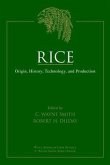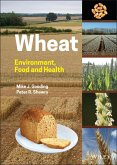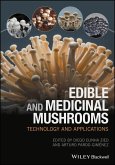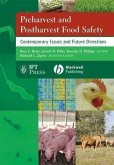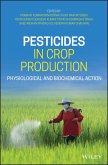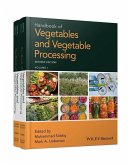Sugar Beet (eBook, PDF)
Redaktion: Draycott, A. Philip


Alle Infos zum eBook verschenken

Sugar Beet (eBook, PDF)
Redaktion: Draycott, A. Philip
- Format: PDF
- Merkliste
- Auf die Merkliste
- Bewerten Bewerten
- Teilen
- Produkt teilen
- Produkterinnerung
- Produkterinnerung

Hier können Sie sich einloggen

Bitte loggen Sie sich zunächst in Ihr Kundenkonto ein oder registrieren Sie sich bei bücher.de, um das eBook-Abo tolino select nutzen zu können.
Sugar beet, alongside sugar cane, is the main source of sugar across the world. Grown widely in Europe, North and South America, Asia and parts of North Africa, the crop is at the core of a multi-billion dollar global industry. A. Philip Draycott has gathered 32 international experts to create this defining text, providing a comprehensive review of the latest research in a clear and accessible form, providing the reader with: * Definitive account of this major world crop * * Coverage of all aspects of successful sugar beet growing * * Over 2,500 references from international literature * *…mehr
- Geräte: PC
- mit Kopierschutz
- eBook Hilfe
- Größe: 11.03MB
![Wheat (eBook, PDF) Wheat (eBook, PDF)]() Wheat (eBook, PDF)279,99 €
Wheat (eBook, PDF)279,99 €![Rice (eBook, PDF) Rice (eBook, PDF)]() Rice (eBook, PDF)466,99 €
Rice (eBook, PDF)466,99 €![Wheat (eBook, PDF) Wheat (eBook, PDF)]() Mike J. GoodingWheat (eBook, PDF)160,99 €
Mike J. GoodingWheat (eBook, PDF)160,99 €![Edible and Medicinal Mushrooms (eBook, PDF) Edible and Medicinal Mushrooms (eBook, PDF)]() Edible and Medicinal Mushrooms (eBook, PDF)189,99 €
Edible and Medicinal Mushrooms (eBook, PDF)189,99 €![Preharvest and Postharvest Food Safety (eBook, PDF) Preharvest and Postharvest Food Safety (eBook, PDF)]() Preharvest and Postharvest Food Safety (eBook, PDF)236,99 €
Preharvest and Postharvest Food Safety (eBook, PDF)236,99 €![Pesticides in Crop Production (eBook, PDF) Pesticides in Crop Production (eBook, PDF)]() Pesticides in Crop Production (eBook, PDF)170,99 €
Pesticides in Crop Production (eBook, PDF)170,99 €![Handbook of Vegetables and Vegetable Processing (eBook, PDF) Handbook of Vegetables and Vegetable Processing (eBook, PDF)]() Handbook of Vegetables and Vegetable Processing (eBook, PDF)354,99 €
Handbook of Vegetables and Vegetable Processing (eBook, PDF)354,99 €-
-
-
Dieser Download kann aus rechtlichen Gründen nur mit Rechnungsadresse in A, B, BG, CY, CZ, D, DK, EW, E, FIN, F, GR, HR, H, IRL, I, LT, L, LR, M, NL, PL, P, R, S, SLO, SK ausgeliefert werden.
- Produktdetails
- Verlag: John Wiley & Sons
- Seitenzahl: 496
- Erscheinungstermin: 8. Mai 2008
- Englisch
- ISBN-13: 9781405173360
- Artikelnr.: 38282267
- Verlag: John Wiley & Sons
- Seitenzahl: 496
- Erscheinungstermin: 8. Mai 2008
- Englisch
- ISBN-13: 9781405173360
- Artikelnr.: 38282267
- Herstellerkennzeichnung Die Herstellerinformationen sind derzeit nicht verfügbar.
.
Contributors.
.
Foreword.
J D Pidgeon, Director, Broom's Barn Research Centre.
.
Preface and Acknowledgements.
A P Draycott, formerly of Broom's Barn Research Centre.
.
1 Introduction.
A P Draycott, formerly of Broom's Barn Research Centre.
Origins of crop.
Production.
Crop improvement.
Where grown.
Sugar consumption.
Economics and politics.
World production of sugar from beet and cane.
Sugar beet performance.
Future.
Summary.
References.
.
2 Development of sugar beet.
S A Francis, Broom's Barn Research Centre.
Introduction.
Early domestication of beet crops.
Development of sugar beet from fodder beet.
Discovery of sugar in roots of beet.
Re-examination of beets for sugar production.
First beet sugar factory.
Achard's legacy.
Establishment of a global beet sugar industry.
Europe.
North and South America.
Asia and Africa.
Technical development of sugar beet.
Plant breeding and genetics.
Agronomy and plant protection.
Crop mechanization.
Future developments.
References.
.
3 Plant structure and crop physiology.
G F J Milford, Rothamsted Research, Harpenden.
Introduction.
Canopy development and dry matter production.
Leaf canopies and radiation interception.
Factors affecting expansion of leaf area.
Storage root development and sugar accumulation.
Storage root development.
Sugar accumulation.
Nutritional physiology and beet quality.
Nitrogen relations.
Potassium and sodium.
Reproductive development.
Physiological and agronomic aspects of bolting.
Genetic and molecular control of flowering.
Summary.
References.
.
4 Genetics and breeding.
N O Bosemark.
Introduction.
Objectives of sugar beet breeding.
Characters subjected to selection.
The inheritance of specific characters.
Autotetraploidy in sugar beet.
Selection methods.
Traditional methods of variety development in sugar beet.
Background to hybrid breeding in sugar beet.
Hybrid breeding methods and development of hybrid varieties.
Breeding for specific characters.
The impact of plant biotechnology on sugar beet breeding.
Strategies in a comprehensive hybrid breeding programme with sugar beet.
References.
.
5 Seed production and quality.
A Kockelmann and U Meyer, KWS .
Introduction.
Methods of beet seed production.
Transplanting method.
Seed production.
Direct production method.
Flowering, maturation and seed harvest.
Flowering.
Maturation and harvest of sugar beet seed.
Drying and cleaning.
Seed yield and propagation ratios.
Seed processing.
Monogerm seed.
Multigerm seed.
Quality testing.
Laboratory methods.
Field tests.
Seed law requirements.
References.
.
6 Soil tillage and crop establishment.
I Håkansson and L Henriksson, Swedish University of Agricultural Sciences,
and J E Blomquist, Agraria Ord & Jord.
Objectives of tillage.
Primary tillage.
Stubble cultivation.
Mouldboard ploughing.
Reduced tillage.
Secondary tillage, sowing and post-sowing tillage.
Requirements for seed germination and plant emergence.
Objectives of seedbed preparation.
The function of the seedbed.
Techniques and implements for seedbed preparation.
Sowing and placement of seed.
Crust formation and crust breaking.
Adaptation to local conditions.
Mechanical weed control.
Soil compaction.
Factors determining compaction.
Short-term effects of compaction.
Long-term effects of plough-layer compaction.
Subsoil compaction.
Subsoil loosening.
Protection against wind erosion.
References.
.
7 Agronomy.
K W Jaggard and A Qi, Broom's Barn Research Centre.
Introduction.
Crop growth.
Patterns during the growing season.
Photosynthesis and growth.
Light interception and yield.
Water use, light intercepted and yield.
Harvest index.
Analysing agronomy in physiological terms.
Assessing light interception.
Sowing date.
Plant establishment and spacing.
Nutrient application.
Harvest date.
Analysing the effects of weeds and virus yellows on growth and yield.
Weeds.
Virus yellows.
Mathematical models and their uses.
References.
.
8 Nutrition - nitrogen.
M Cariolle and R Duval, Institut Technique Francais de la Betterave
Industrielle Service Agronomie.
Importance.
Nitrogen uptake and concentration.
Nitrogen deficiency and its detection.
Effect of nitrogen on germination, emergence and establishment.
Effect of nitrogen on growth and yield.
Effect of nitrogen on root quality.
Soil supplies of nitrogen.
Form and application of nitrogen fertilizer.
Interactions with the environment.
Summary and conclusions.
References.
.
9 Nutrition - phosphorus, sulphur, potassium, sodium, calcium, magnesium
and micronutrients - liming and nutrient deficiencies.
D R Christenson and A P Draycott.
Introduction.
Phosphorus.
Sulphur.
Potassium.
Sodium.
Calcium.
Magnesium.
Micronutrients or trace elements.
Soil acidity and liming.
Nutrient deficiencies.
References.
.
10 Water use and irrigation.
R Morillo-Velarde, Associacion de Investigacion para la Mejora de Cultivo
de la Remolacha Azucarera C/Metalurgian 36 and E S Ober, Broom's Barn
Research Centre.
Introduction.
Water and physiology.
Defining the water status of plants and soils.
Water use by sugar beet.
Irrigation management.
Responses to irrigation.
Irrigation practices.
Deficit irrigation.
Salinity.
Germination and emergence.
Irrigation and other factors.
Drought tolerance.
References.
.
11 Virus diseases.
M Stevens, Broom's Barn Research Centre, H-Y Liu, USDA-ARS and O Lemaire,
INRA Equipe Vection.
Rhizomania.
Symptoms and damage.
Development and spread.
Causal agents.
Control.
Other soil-borne viruses.
Beet soil-borne.
Beet soil-borne mosaic.
Beet virus Q.
Beet oak-leaf.
Beet distortion mosaic.
Virus yellows.
Poleroviruses.
Beet yellows.
Other diseases.
References.
.
12 Fungal and bacterial diseases.
M J C Asher, Broom's Barn Research Centre and L E Hanson, USDA-ARS.
Introduction.
Seedling diseases.
Aphanomycesseedling disease.
Pythiumdamping-off.
Rhizoctoniadamping-off.
Phomaseedling disease.
Foliar diseases.
Cercospora leaf spot.
Powdery mildew.
Downy mildew.
Rust.
Ramularia leaf spot.
Phoma leaf spot.
Alternaria leaf spot.
Beet tumour (Urophlyctis).
Rhizoctonia foliar blight.
Root diseases.
Aphanomycesroot rot.
Rhizoctoniaroot and crown rot.
Violet root rot.
Charcoalrot.
Phymatotrichumroot rot.
Phytophthoraroot rot.
Pythiumroot rot.
Rhizopusroot rot.
Southern sclerotium root rot.
Phomaroot rot.
Fusariumroot rot.
Fusarium yellows.
Verticilliumwilt.
Bacterial diseases.
Beet vascular necrosis and rot.
Bacterial leaf spot.
Crown gall.
Scab.
Yellow wilt.
Latent rosette.
Low sugar syndrome (Basses richesses).
References.
.
13 Pests.
A M Dewar, Broom's Barn Research Centre and D A Cooke.
Introduction.
Effects of pests on establishment, growth and yield.
Crop establishment.
Defoliation.
Foliar efficiency.
Root growth.
Disease vectors.
Distribution, biology, and pathogenicity of major pests.
Nematodes.
Slugs.
Arthropods.
Vertebrate pests.
Minimizing yield losses caused by pests.
Forecasting.
Crop rotation.
Other cultural control methods.
Resistant sugar beet cultivars.
Resistant catch crops.
Pesticides.
Beneficial organisms and biological control.
References.
.
14 Weeds and weed control.
M J May, Broom's Barn Research Centre and R G Wilson, University of
Nebraska.
Introduction.
Weeds.
Distribution and agricultural importance.
Biology of major weeds.
Effect of weeds on wildlife.
Weed competition and the effect of time of removal.
Weed control.
Physical methods.
Chemical methods.
Biological control.
Weed control outside the sugar beet crop.
In the rotation.
In fallow lay-by situations.
Herbicide resistance.
Crop varieties.
Weeds.
Crop injury from herbicides.
References.
.
15 Storage.
L G Campbell, and K L Klotz, USDA.
Introduction.
Respiration.
Carbohydrate impurity formation.
Invert sugars.
Raffinose.
Polysaccharide gums.
Kestoses.
Storage rots.
Crop management and growing conditions.
Reducing mechanical damage.
Storage pile management.
References.
.
16 Root quality and processing.
J V Dutton, Sugar Industry and Biotechnology Consultancy and A W M
Huijbregts, IRS.
Introduction.
Historical overview of beet technical quality.
Concepts of good beet quality.
Quality parameters.
Sugar content.
Major non-sugars.
Reducing sugars.
Betaine.
Raffinose.
Dextran and levan.
Enzymes.
Marc.
Physical properties.
Tare.
Factors influencing quality.
Introduction.
Climate.
Variety.
Fertilizer.
Other agronomic factors.
Harvesting and topping.
Storage.
Factory beet handling.
Evolution of beet quality.
Conclusions.
References.
.
17 Co-products.
J I Harland, C K Jones, Wyoming Sugar Company and V C Hufford, Midwest
Agri-Commodities.
Introduction.
Sugar beet roots.
Sugar beet tops.
Analysis and feeding value.
Feeding sugar beet tops.
Sugar beet pulp.
Characterization of sugar beet pulp.
Analysis and feeding values of sugar beet pulp.
Feeding sugar beet pulp.
Other uses of sugar beet pulp.
Sugar beet molasses.
Analysis and feeding value of sugar beet molasses.
Feeding levels of sugar beet molasses.
Other uses for sugar beet molasses.
Molassed sugar beet pulp (feed).
Molassed pressed pulp.
Dried molassed sugar beet feed.
Beet vinasse.
Concluding remarks.
References.
.
Index
.
Contributors.
.
Foreword.
J D Pidgeon, Director, Broom's Barn Research Centre.
.
Preface and Acknowledgements.
A P Draycott, formerly of Broom's Barn Research Centre.
.
1 Introduction.
A P Draycott, formerly of Broom's Barn Research Centre.
Origins of crop.
Production.
Crop improvement.
Where grown.
Sugar consumption.
Economics and politics.
World production of sugar from beet and cane.
Sugar beet performance.
Future.
Summary.
References.
.
2 Development of sugar beet.
S A Francis, Broom's Barn Research Centre.
Introduction.
Early domestication of beet crops.
Development of sugar beet from fodder beet.
Discovery of sugar in roots of beet.
Re-examination of beets for sugar production.
First beet sugar factory.
Achard's legacy.
Establishment of a global beet sugar industry.
Europe.
North and South America.
Asia and Africa.
Technical development of sugar beet.
Plant breeding and genetics.
Agronomy and plant protection.
Crop mechanization.
Future developments.
References.
.
3 Plant structure and crop physiology.
G F J Milford, Rothamsted Research, Harpenden.
Introduction.
Canopy development and dry matter production.
Leaf canopies and radiation interception.
Factors affecting expansion of leaf area.
Storage root development and sugar accumulation.
Storage root development.
Sugar accumulation.
Nutritional physiology and beet quality.
Nitrogen relations.
Potassium and sodium.
Reproductive development.
Physiological and agronomic aspects of bolting.
Genetic and molecular control of flowering.
Summary.
References.
.
4 Genetics and breeding.
N O Bosemark.
Introduction.
Objectives of sugar beet breeding.
Characters subjected to selection.
The inheritance of specific characters.
Autotetraploidy in sugar beet.
Selection methods.
Traditional methods of variety development in sugar beet.
Background to hybrid breeding in sugar beet.
Hybrid breeding methods and development of hybrid varieties.
Breeding for specific characters.
The impact of plant biotechnology on sugar beet breeding.
Strategies in a comprehensive hybrid breeding programme with sugar beet.
References.
.
5 Seed production and quality.
A Kockelmann and U Meyer, KWS .
Introduction.
Methods of beet seed production.
Transplanting method.
Seed production.
Direct production method.
Flowering, maturation and seed harvest.
Flowering.
Maturation and harvest of sugar beet seed.
Drying and cleaning.
Seed yield and propagation ratios.
Seed processing.
Monogerm seed.
Multigerm seed.
Quality testing.
Laboratory methods.
Field tests.
Seed law requirements.
References.
.
6 Soil tillage and crop establishment.
I Håkansson and L Henriksson, Swedish University of Agricultural Sciences,
and J E Blomquist, Agraria Ord & Jord.
Objectives of tillage.
Primary tillage.
Stubble cultivation.
Mouldboard ploughing.
Reduced tillage.
Secondary tillage, sowing and post-sowing tillage.
Requirements for seed germination and plant emergence.
Objectives of seedbed preparation.
The function of the seedbed.
Techniques and implements for seedbed preparation.
Sowing and placement of seed.
Crust formation and crust breaking.
Adaptation to local conditions.
Mechanical weed control.
Soil compaction.
Factors determining compaction.
Short-term effects of compaction.
Long-term effects of plough-layer compaction.
Subsoil compaction.
Subsoil loosening.
Protection against wind erosion.
References.
.
7 Agronomy.
K W Jaggard and A Qi, Broom's Barn Research Centre.
Introduction.
Crop growth.
Patterns during the growing season.
Photosynthesis and growth.
Light interception and yield.
Water use, light intercepted and yield.
Harvest index.
Analysing agronomy in physiological terms.
Assessing light interception.
Sowing date.
Plant establishment and spacing.
Nutrient application.
Harvest date.
Analysing the effects of weeds and virus yellows on growth and yield.
Weeds.
Virus yellows.
Mathematical models and their uses.
References.
.
8 Nutrition - nitrogen.
M Cariolle and R Duval, Institut Technique Francais de la Betterave
Industrielle Service Agronomie.
Importance.
Nitrogen uptake and concentration.
Nitrogen deficiency and its detection.
Effect of nitrogen on germination, emergence and establishment.
Effect of nitrogen on growth and yield.
Effect of nitrogen on root quality.
Soil supplies of nitrogen.
Form and application of nitrogen fertilizer.
Interactions with the environment.
Summary and conclusions.
References.
.
9 Nutrition - phosphorus, sulphur, potassium, sodium, calcium, magnesium
and micronutrients - liming and nutrient deficiencies.
D R Christenson and A P Draycott.
Introduction.
Phosphorus.
Sulphur.
Potassium.
Sodium.
Calcium.
Magnesium.
Micronutrients or trace elements.
Soil acidity and liming.
Nutrient deficiencies.
References.
.
10 Water use and irrigation.
R Morillo-Velarde, Associacion de Investigacion para la Mejora de Cultivo
de la Remolacha Azucarera C/Metalurgian 36 and E S Ober, Broom's Barn
Research Centre.
Introduction.
Water and physiology.
Defining the water status of plants and soils.
Water use by sugar beet.
Irrigation management.
Responses to irrigation.
Irrigation practices.
Deficit irrigation.
Salinity.
Germination and emergence.
Irrigation and other factors.
Drought tolerance.
References.
.
11 Virus diseases.
M Stevens, Broom's Barn Research Centre, H-Y Liu, USDA-ARS and O Lemaire,
INRA Equipe Vection.
Rhizomania.
Symptoms and damage.
Development and spread.
Causal agents.
Control.
Other soil-borne viruses.
Beet soil-borne.
Beet soil-borne mosaic.
Beet virus Q.
Beet oak-leaf.
Beet distortion mosaic.
Virus yellows.
Poleroviruses.
Beet yellows.
Other diseases.
References.
.
12 Fungal and bacterial diseases.
M J C Asher, Broom's Barn Research Centre and L E Hanson, USDA-ARS.
Introduction.
Seedling diseases.
Aphanomycesseedling disease.
Pythiumdamping-off.
Rhizoctoniadamping-off.
Phomaseedling disease.
Foliar diseases.
Cercospora leaf spot.
Powdery mildew.
Downy mildew.
Rust.
Ramularia leaf spot.
Phoma leaf spot.
Alternaria leaf spot.
Beet tumour (Urophlyctis).
Rhizoctonia foliar blight.
Root diseases.
Aphanomycesroot rot.
Rhizoctoniaroot and crown rot.
Violet root rot.
Charcoalrot.
Phymatotrichumroot rot.
Phytophthoraroot rot.
Pythiumroot rot.
Rhizopusroot rot.
Southern sclerotium root rot.
Phomaroot rot.
Fusariumroot rot.
Fusarium yellows.
Verticilliumwilt.
Bacterial diseases.
Beet vascular necrosis and rot.
Bacterial leaf spot.
Crown gall.
Scab.
Yellow wilt.
Latent rosette.
Low sugar syndrome (Basses richesses).
References.
.
13 Pests.
A M Dewar, Broom's Barn Research Centre and D A Cooke.
Introduction.
Effects of pests on establishment, growth and yield.
Crop establishment.
Defoliation.
Foliar efficiency.
Root growth.
Disease vectors.
Distribution, biology, and pathogenicity of major pests.
Nematodes.
Slugs.
Arthropods.
Vertebrate pests.
Minimizing yield losses caused by pests.
Forecasting.
Crop rotation.
Other cultural control methods.
Resistant sugar beet cultivars.
Resistant catch crops.
Pesticides.
Beneficial organisms and biological control.
References.
.
14 Weeds and weed control.
M J May, Broom's Barn Research Centre and R G Wilson, University of
Nebraska.
Introduction.
Weeds.
Distribution and agricultural importance.
Biology of major weeds.
Effect of weeds on wildlife.
Weed competition and the effect of time of removal.
Weed control.
Physical methods.
Chemical methods.
Biological control.
Weed control outside the sugar beet crop.
In the rotation.
In fallow lay-by situations.
Herbicide resistance.
Crop varieties.
Weeds.
Crop injury from herbicides.
References.
.
15 Storage.
L G Campbell, and K L Klotz, USDA.
Introduction.
Respiration.
Carbohydrate impurity formation.
Invert sugars.
Raffinose.
Polysaccharide gums.
Kestoses.
Storage rots.
Crop management and growing conditions.
Reducing mechanical damage.
Storage pile management.
References.
.
16 Root quality and processing.
J V Dutton, Sugar Industry and Biotechnology Consultancy and A W M
Huijbregts, IRS.
Introduction.
Historical overview of beet technical quality.
Concepts of good beet quality.
Quality parameters.
Sugar content.
Major non-sugars.
Reducing sugars.
Betaine.
Raffinose.
Dextran and levan.
Enzymes.
Marc.
Physical properties.
Tare.
Factors influencing quality.
Introduction.
Climate.
Variety.
Fertilizer.
Other agronomic factors.
Harvesting and topping.
Storage.
Factory beet handling.
Evolution of beet quality.
Conclusions.
References.
.
17 Co-products.
J I Harland, C K Jones, Wyoming Sugar Company and V C Hufford, Midwest
Agri-Commodities.
Introduction.
Sugar beet roots.
Sugar beet tops.
Analysis and feeding value.
Feeding sugar beet tops.
Sugar beet pulp.
Characterization of sugar beet pulp.
Analysis and feeding values of sugar beet pulp.
Feeding sugar beet pulp.
Other uses of sugar beet pulp.
Sugar beet molasses.
Analysis and feeding value of sugar beet molasses.
Feeding levels of sugar beet molasses.
Other uses for sugar beet molasses.
Molassed sugar beet pulp (feed).
Molassed pressed pulp.
Dried molassed sugar beet feed.
Beet vinasse.
Concluding remarks.
References.
.
Index


